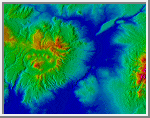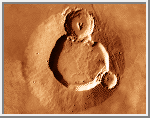Skip to comments.
60M-Year-Old Meteor Crater Mapped In North Sea
Ananova ^
| 7-31-2002
Posted on 07/31/2002 8:08:28 AM PDT by blam
60m-year-old meteor crater mapped in North Sea
Scientists have mapped a small but well-preserved crater in the North Sea formed by a meteorite they believe smacked into Earth 60 to 65 million years ago.
The impact crater measures about six miles wide and sits beneath 120 feet of seawater and more than 900 feet of sediment.
Researchers believe the so-called Silverpit crater was formed after the catastrophic impact near Mexico's Yucatan Peninsula that scientists suspect contributed to the extinction of the dinosaurs.
"We know so little about how impact structures are created when meteorites and comets hit," said University of New Brunswick geologist John G. Spray, who reviewed the crater data for the journal Nature, which published details in its current issue. "Any new example helps."
Details of most impact craters on Earth have eroded by rain, wind and earthquakes over millions of years.
The simplest type of impact crater is a smooth, bowl-shaped depression like the famous Baringer Crater in Arizona. By comparison, the Silverpit is shaped like a basin with multiple rings like shock waves encircling the sides, scientists said.
Silverpit's main crater is 1.5 miles (2.4 kilometers) wide with a central peak that probably formed when the Earth rebounded from the impact of the incoming cosmic projectile, scientists said.
A series of at least 10 concentric impact rings radiate beyond it, expanding its size to some degree. Still, it's small and well-preserved as craters go and that makes it "very intriguing," Spray said.
The Silverpit crater was identified by a pair of petroleum geoscientists reviewing seismic data collected 80 miles (130 kilometers) from the city of Hull in northeast England.
They mapped the crater's features using powerful three-dimensional computer imaging normally reserved to plan energy drilling.
Story filed: 14:43 Wednesday 31st July 2002
TOPICS: News/Current Events
KEYWORDS: 60m; asteroid; asteroids; astronomy; catastrophism; impact; meteor; meteors; north; old; science; sea; year
Incoming!
1
posted on
07/31/2002 8:08:28 AM PDT
by
blam
To: blam
Cool!
2
posted on
07/31/2002 8:11:36 AM PDT
by
Ciexyz
To: blam
3
posted on
07/31/2002 8:13:40 AM PDT
by
blam
To: blam
I don't think "duck and cover" would help much...
To: blam
No estimate of size of meteorite?
5
posted on
07/31/2002 8:27:22 AM PDT
by
eastsider
To: blam
These things really qualify as asteroids, I guess.
But don't ice ages occur in regular "cycles?"
6
posted on
07/31/2002 8:28:46 AM PDT
by
Sam Cree
To: blam
Silverpit's main crater is 1.5 miles (2.4 kilometers) wide with a central peak that probably formed when the Earth rebounded from the impact of the incoming cosmic projectile, scientists said.
For comparison purposes, a 1.13 kilometer terrestrial meteorite crater:

An aerial photograph of the 1.13-km-diameter Pretoria Saltpan impact crater (also known as the Tswaing Crater) in South Africa. At Tswaing, a major museum is currently being developed, with the aim at providing the several million people living in the region around this site with multidisciplinary natural science and environmental education. View towards the west.
7
posted on
07/31/2002 8:33:42 AM PDT
by
eastsider
To: blam; eastsider
My reply 103 at
Disaster that struck the ancients, BBC, July 26, 2001, by Fekri Hassan (posted December 8, 2001 by
blam).

Valles Caldera
I wonder that the Valles Caldera of the Jemez Mountain Range, though now classified as "resurgent," was initiated by impact.
I suspect that an impact where the Earth's magma subsurface level is "just right," effectively "fractures" the crust of the earth and in slow motion, resembles something like this:

Combine High Speed and Time Lapse, BMumford.com
Ulysses Patera on Mars, showing two impact craters of later dates than the resurgent structure.
The smaller impacts did not cause "fractures." While the larger, older impact did, causing a large outward plume, some of which then collapsed back upon the hole, the heat and heat of vibration smoothing the matter --- whereas in the case of the Valles Caldera, the resulting splash is Redondo:

It's just a theory.
____
Then, in the above article:
Silverpit's main crater is 1.5 miles (2.4 kilometers) wide with a central peak that probably formed when the Earth rebounded from the impact of the incoming cosmic projectile, scientists said.
To: First_Salute
I suspect that an impact where the Earth's magma subsurface level is "just right," effectively "fractures" the crust of the earth ... (Ulysses Patera on Mars, showing two impact craters of later dates than the resurgent structure.)
Impressive.
9
posted on
07/31/2002 9:19:51 AM PDT
by
eastsider
To: Sam Cree
"But don't ice ages occur in regular "cycles?" I thought so too. Maybe this incident started the cycle.
The whole front page of the september issue of Discover Magazine is devoted to The Coming Ice Age. They say we could be on the verge of one like The Little Ice Age(1300-1850AD) any day now.
10
posted on
07/31/2002 2:15:54 PM PDT
by
blam
To: blam
Hi Blam,
Thanks for the post. I just returned from a 5 day out of town trip, so will read this now.
"They say we could be on the verge of one like The Little Ice Age(1300-1850AD) any day now."
That's interesting. Where I grew up in Virginia, there are still ice ponds left over from then. These were little ponds dug to make ice. During the Little Ice Age, they would freeze solid, providing enough ice, if kept in a covered pit, to last all through the following summer. But it's been a long time since you could use an ice pond in central Virginia.
However I think I'll get a copy of Discover Magazine and check out the article.
11
posted on
08/06/2002 12:13:31 PM PDT
by
Sam Cree
To: Sam Cree
"Where I grew up in Virginia, there are still ice ponds left over from then. These were little ponds dug to make ice. During the Little Ice Age, they would freeze solid, providing enough ice, if kept in a covered pit, to last all through the following summer." Yup. That was back during the time that ice ships would make regular scheduled visits to the south with ice. That period ended when the doctor in Apalachicola, Florida invented the world's first ice machine.
12
posted on
08/06/2002 1:41:24 PM PDT
by
blam
To: 75thOVI; Abathar; agrace; aimhigh; Alice in Wonderland; AnalogReigns; AndrewC; aragorn; ...
This topic was posted , thanks blam.
13
posted on
03/01/2022 9:33:38 AM PST
by
SunkenCiv
(Imagine an imaginary menagerie manager imagining managing an imaginary menagerie.)
Disclaimer:
Opinions posted on Free Republic are those of the individual
posters and do not necessarily represent the opinion of Free Republic or its
management. All materials posted herein are protected by copyright law and the
exemption for fair use of copyrighted works.
FreeRepublic.com is powered by software copyright 2000-2008 John Robinson





